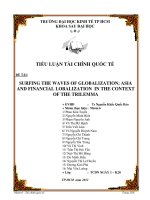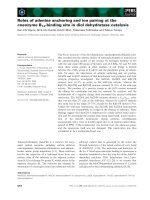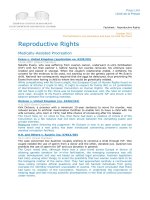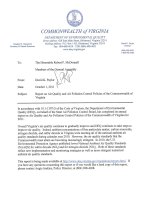Lecture Microeconomics - Chapter 4: Supply, Demand and Gov Policies
Bạn đang xem bản rút gọn của tài liệu. Xem và tải ngay bản đầy đủ của tài liệu tại đây (695.45 KB, 33 trang )
TOPIC 4
SUPPLY, DEMAND
AND GOVERNMENT POLICIES
4.1
4.2
CONTROL
ON PRICES
TAXES
HUTECH Institute of International Education
Supply, Demand and Government policies
4.1 CONTROL ON PRICES
▪ The interests between buyers and sellers conflict
▪ The control on prices enacted when policymakers believe that the market price is unfair to
buyers and sellers.
▪ Result in government policies, i.e. price ceilings
and price floors.
HUTECH Institute of International Education
Control on Prices
CONTROL ON PRICES
▪ Price controls
➢ Price ceiling: a legal maximum on the price
of a good or service
➢ Price floor: a legal minimum on the price of
a good or service
Effects on the market outcome?
HUTECH Institute of International Education
Control on Prices
Price Ceiling
A price ceiling is the maximum legal price a seller may
charge for a product or service shown in the graph below:
P
S
Pe
Price Ceiling
Pc
PC is the
maximum legal
price that a firm
can charge!
D
QS
Qe
QD
Q
Excess Demand
HUTECH Institute of International Education
4
Why impose a Price ceiling?
• To keep the price down to an acceptable level.
• During wartime price controls may be imposed on
essential items such as petrol, rice etc.
• To help the poor & the disadvantaged
HUTECH Institute of International Education
A market with a price ceiling
(a) A price ceiling that is not binding
Price
(b) A price ceiling that is binding
Price
Supply
Supply
Price ceiling
$4
Equilibrium
price
3
$3
Equilibrium
price
Price ceiling
2
Demand
Shortage
Equilibrium
quantity
0
100
Quantity of Ice-Cream Cones
➔ No effects on the price or quantity sold
HUTECH Institute of International Education
Quantity
supplied
0
Demand
Quantity
demanded
125
75
Quantity of Ice-Cream Cones
➔ The ration mechanism – not desirable
Control on Prices
Lines at the gas pump
• 1973, OPEC raised the price of crude oil
– Reduced the supply of gasoline
– Long lines at gas stations
• What was responsible for the long gas lines?
– OPEC: created shortage of gasoline
– U.S. government regulations: price ceiling on gasoline
• Before OPEC raised the price of crude oil
– Equilibrium price - below price ceiling: no effect
• When the price of crude oil rose
– Reduced the supply of gasoline
– Equilibrium price – above price ceiling: shortage
Lines at the gas pump
P
S1
P
S2
S1
P2
PC
PC
P1
E
Ceiling price
P1
Ceiling price
D
Q1
Lượng
When OPEC remains Q,
Q2 QC Q1
Lượng
P1 < Ceiling price
- When OPEC increases P → reduces
Q → S curve move to the left
→ No effect on P or Q
- Without Ceiling Price??
- With Ceiling price? Why lines at gas
pump?
HUTECH Institute of International Education
Control on Prices
Rent control in the short run
and the long run
• Price ceiling: rent control
– Local government - ceiling on rents
– Goal: help the poor (housing more affordable)
– But what’re the real effects?
Rent control in short and long run
In short run:
Rent
price
D
S
✓ Number of rent houses are
considered
unchanged
(because
landlord cannot change these number
in short time) → S curve is vertical
Ceiling price
PC
Shortage
Q
No of houses rent
SHORT TERM
HUTECH Institute of International Education
✓Tenants may not be responsive to
rents because of living habit, they
need time → D curve is relatively
slope
✓S and D curves for apartments
are relatively inelastic
→ Small shortage
10
Rent control in short and long run
In long run:
Rent
price
D
✓ Supply side: Landlords - not
building new apartments & failing to
maintain existing ones; reduce
number of house rents
S
→ Supply is elastic → S curve is flat
Ceiling price
PC
Shoratge
Q
No of houses rent
LONG TERM
HUTECH Institute of International Education
✓ Demand side: - find their own
apartments & induce more people to
move into a city
→ Demand is elastic → D curve is
flat
→ Large shortage of housing
11
Rent control in the short run
and the long run
• Adverse effects of rent control in the long run
– Rationing mechanisms
• Long waiting lists
• Preference to tenants without children
•…
– Tenants get lower rents but also lower-quality house
Price Floor
Price floors are minimum prices fixed by government that
are above equilibrium prices.
P
S
Price Floors
Pf
Pe
Pf is the minimum
legal price that a
firm can charge
D
Qf
Qe
QD
Q
Excess Supply
HUTECH Institute of International Education
13
Why impose a price floor?
• To support prices (income) in important sectors of the
economy (eg. Agriculture).
• To protect workers (eg. minimum wages)
HUTECH Institute of International Education
A market with a price floor
(a) A price floor that is not binding
Price
(b) A price floor that is binding
Price
Surplus
Supply
Supply
$4
Price floor
3
$3
Equilibrium
price
Equilibrium
price
Price floor
2
Demand
Demand
Quantity
demanded
Equilibrium
quantity
0
100
Quantity of Ice-Cream Cones
➔ No effects on the price or quantity sold
HUTECH Institute of International Education
0
Quantity
supplied
120
80
Quantity of Ice-Cream Cones
➔ Binding price floor causes a surplus.
Control on Prices
The minimum wage
• Price floor: minimum wage
– Lowest price for labor that any employer may pay
• Fair Labor Standards Act of 1938
– Ensure workers a minimally adequate standard of
living
• If minimum wage – above equilibrium
– Unemployment
– Higher income - workers who have jobs
– Lower income - workers who cannot find jobs
16
The minimum wage
•If minimum wage is
above equilibrium
– Unemployment
– Raise income of
workers who have
jobs
– Lower income of
workers who cannot
find jobs
(b) A Labor Market with a
Binding Minimum Wage
Wage
Labor surplus
(unemployment)
Labor
supply
Minimum
wage
Labor
demand
0
Quantity
demanded
Quantity Quantity
supplied of Labor
The minimum wage
• Impact of the minimum wage
– Workers with high skills and much experience
• Not affected: Equilibrium wages - above the
minimum
• Minimum wage - not binding
– Teenage labor – least skilled and least
experienced
• Low equilibrium wages
• Willing to accept a lower wage in exchange for onthe-job training
• Minimum wage – binding
18
Evaluating Price controls
▪ Principle of Economics: “Markets are usually a
good way to organize economic activity”
- Economists usually oppose price ceilings and
price floors
• Prices are aim to balance supply and
demand – thereby coordinate economic
activity
HUTECH Institute of International Education
Control on Prices
Evaluating Price controls
▪ Principle of Economics: “Governments can
sometimes improve market outcomes”
- Impose price controls: because of unfair
market outcome
• Aimed at helping the poor
• Often hurt those they are trying to help
• Other ways of helping those in need
- Rent subsidies
- Wage subsidies
HUTECH Institute of International Education
Control on Prices
4.2 TAXES
▪ Government can make buyers or sellers pay tax.
▪ Tax can be a % of the good’s price, or a specific
amount for each unit sold.
Who actually bears the burden of tax
Buyers? Or Sellers?
Tax incidence: the manner in which the burden of
a tax is shared among participants in a market
HUTECH Institute of International Education
Control on Prices
Taxes on sellers
▪ Step 1: impact the sellers
→ shifts the S curve
▪ Step 2: the cost of producing increases
→ reduces the QS at every price
→ S curve shifts to the left
▪Step 3: Tax lead to higher P* and lower Q*
➔ Taxes reduce size of the market
HUTECH Institute of International Education
Control on Prices
Taxes on sellers
Price of
Ice-Cream
Cone
Price
buyers
pay
Price
without
tax
Equilibrium with tax
S2
S1
A tax on sellers
shifts the supply
curve upward
by the size of
the tax ($0.50).
$3.30
Tax
($0.50)
3.00
Equilibrium without tax
2.80
Price
sellers
receive
Demand, D1
0
90
100
Quantity of
Ice-Cream Cones
→ Tax discourage the market activity
→ Buyers pay more and sellers receive less
HUTECH Institute of International Education
Control on Prices
Taxes on buyers
▪ Step 1: impact the buyers
→ shifts the D curve
▪ Step 2: buying ice-cream become less attractive
→ reduces the QD at every price
→ D curve shifts downward to the left
▪Step 3: Tax lead to lower P* and lower Q*
➔ Taxes reduce size of the market
HUTECH Institute of International Education
Control on Prices
Taxes on buyers
Price of
Ice-Cream
Cone
Price
buyers
pay
Price
without
tax
Equilibrium with tax
Supply, S1
Equilibrium without tax
$3.30
A tax on buyers
shifts the demand
curve downward
by the size of
the tax ($0.50).
Tax
($0.50)
3.00
2.80
Price
sellers
receive
D1
D2
0
90
100
Quantity of
Ice-Cream Cones
Taxes levied on sellers and taxes levied on buyers are equivalent
HUTECH Institute of International Education
Control on Prices









